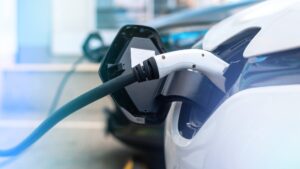There is no doubt that electric vehicles (EVs) offer many environmental benefits compared to traditional internal combustion engine vehicles that rely on fossil fuels. Seeing more and more electric cars hit the road is an exciting moment in the push for sustainability. However, it is important to pause for a minute and be critical: how sustainable is the process of producing the lithium batteries that power the electric cars? Some people have described lithium as “the non-renewable mineral that makes renewable energy possible”. While lithium fuels the clean energy revolution, it is important to understand where lithium comes from, how it is sourced, and what the end-of-life cycle looks like.
Join us as we dig deeper into this often-overlooked part of the electric vehicle revolution!
 Lithium is a lightweight metal that is highly reactive and found in minerals and brines. It is commonly used in rechargeable batteries, mental health treatments, and materials like glass and ceramics. Its role in lithium-ion batteries makes it essential for powering electric vehicles, helping to reduce reliance on fossil fuels. But what exactly is the environmental impact of lithium extraction and processing?
Lithium is a lightweight metal that is highly reactive and found in minerals and brines. It is commonly used in rechargeable batteries, mental health treatments, and materials like glass and ceramics. Its role in lithium-ion batteries makes it essential for powering electric vehicles, helping to reduce reliance on fossil fuels. But what exactly is the environmental impact of lithium extraction and processing?
Habitat Destruction
Lithium is often found in fragile ecosystems like salt flats and Andean highlands. Open-pit mining destroys these landscapes, displacing animal populations and disrupting ecosystem stability. The construction of roads and infrastructure associated with mining further destroys habitats, making it harder for animals to breed and find food.
Water Shortages
Extracting lithium from brines requires massive amounts of water. This can lead to water shortages in already arid regions. For example, lithium extraction in the Atacama Desert, one of the driest places on Earth, has severely depleted its underground water reserves, impacting local communities and ecosystems.
Soil Contamination
Mining activities can leave behind piles and piles of waste rock and process leftovers, which can leak harmful chemicals into the soil. These chemicals can then enter the food chain, harming plants and animals. Additionally, accidents and spills during extraction can further contaminate the soil.
Water Pollution
The brines used in lithium extraction often contain high concentrations of salts and heavy metals. If not properly treated and disposed of, these brines can contaminate nearby water sources, making them unusable for drinking, irrigation, or aquatic life. Leakage from evaporation ponds used in the extraction process can also contribute to water pollution.
All this sounds horrible, doesn’t it? This is why researchers are actively exploring alternative extraction methods that utilize less water and minimize environmental damage. Here are a few examples:
Direct Lithium Extraction (DLE)
This method uses solvents to extract lithium directly from brines, potentially reducing water consumption.
Geothermal Lithium Extraction
This method uses geothermal brines rich in lithium, potentially offering a more sustainable approach. These brines are hot, salty water solutions found deep within the Earth’s crust. They are heated by the planet’s internal heat and become enriched with minerals as they circulate through rocks. These brines are often used as a heat source for geothermal power plants, where their heat is converted into electricity.
Lithium Recycling
Giving old batteries a second life reduces the need to dig up fresh lithium.
At the end of their life, lithium-ion batteries pose environmental challenges if not properly managed. While they are often disposed of in landfills or incinerated, this can lead to toxic chemical leakage and resource waste. However, they can be recycled to recover valuable materials like lithium, cobalt, and nickel, reducing the need for new mining and minimizing environmental impact. Current recycling methods, such as hydrometallurgical and pyrometallurgical processes, are improving but remain energy-intensive and costly. Expanding battery recycling infrastructure and developing more efficient, sustainable recovery technologies are key to reducing pollution and resource depletion.
Fortunately, there’s a ray of hope on the horizon for already existing lithium-ion batteries. Researchers in Japan have developed a method to potentially revive degraded batteries, restoring up to 80% of their capacity through a chemical injection process. This could significantly reduce the environmental impact of lithium extraction and processing by extending battery life and lessening the need for constant replacements. While large-scale application is still under development, this new technology offers a promising step towards a more sustainable future for lithium-ion batteries.

Even though the production of lithium batteries has a significant environmental impact, the long-term benefits of electric vehicles are considerably higher compared to petrol/diesel vehicles. EV’s produce fewer greenhouse gas emissions compared to traditional vehicles, especially when charged with electricity that is generated by renewable sources such as wind or solar. They are generally more energy efficient and produce less noise pollution compared to conventional cars, contributing to the improvement of public health. Bottom line, electrical vehicles have, by far, less environmental impact compared to combustion engine vehicles. However, efforts to minimize the environmental footprint of lithium mining and battery production are essential. Sustainable practices, recycling, and technological innovations are crucial in ensuring that the overall environmental benefits of electric vehicles are maximized while mitigating the negative impacts of their production process.
Images used in this blog post are designed by Freepik.